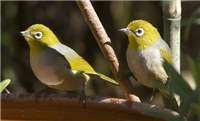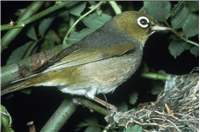Family
Zosteropidae
Genus
Zosterops
Species
lateralis
Threats/Control Methods - Regional
Silvereyes themselves pose a threat to Australia's native wildlife through their tendency to spread invasive weeds.
Threats/Control Methods - Local
Free roaming domestic pets may attack and kill this tame and garden-dwelling species.
Local/Urban Actions
Suburban gardeners should avoid keeping weed species, as they encourage Silvereyes to carry the fruits and seeds to other areas, contributing to Australia's current weed problems. Any fruit trees can be protected from these hungry birds by netting or sound and visual deterrents. Cat owners can minimise harm to birds by providing a stimulating indoor environment and a cat run or enclosure for their pets.
Common Names
Silvereye, Blightbird, Green-backed Silvereye, Grape-eater, Greenie, Grey Silvereye, White-eye, Ring-eye, Silvey, Spectacled Blightbird, Tauhou, Wax-eye
Distinguishing Features
The Silvereye is a small bird with a conspicuous white eye-ring. Its beak, legs and back are black and the wings and head are olive-green. Breeding birds have yellow throats, pale belly sides and a white undertail.
Survey Techniques
Call and visual identification.
Species Call
Repeated high pitched notes. Otherwise a quieter, pleasant song, including mimicry of other birds.
Similar Species
The Yellow White-eye is similar, however it is only found in far north regions of Australia. It is also found in the surrounding islands of New Zealand, Fiji. Lord Howe Island and Norfolk Island.
Distribution
Right across southern Australia and a thick coastal band through northern NSW and QLD.
Country of Origin
Australia
Conservation (Pet/Pest) Status - Regional
Breeding records show a slight decline in the last 15 years. In Canberra, numbers peak from April to July (COG).
Conservation (Pet/Pest) Status - National
Secure, not listed under the EPBC Act 1999. In some commercial orchards they are considered a pest. The population of Lord Howe Island, Zosterops lateralis tephropleurus, is vulnerable, confined to a small area and susceptible to pest introduction.
LSCCES Population
The species was found over most of the Sullivans Creek Catchment, with highest numbers recorded at ANBG and no sightings at the NMA.
Associated vegetation community
Silvereyes have a mostly woodland habitat, with a preference for orchards or urban parks and gardens.
Limiting Resources
This species prefers disturbed, suburban vegetation such as lantana and privet. Its diet will vary with availability, however orchard fruit are preferred.
Breeding
The nest is a small, neatly woven cup of grasses, hair, and other fine vegetation, bound with spider web and hidden in a tree or shrub just above the ground. The duration of a full breeding cycle is about 10 weeks. 2 or 3 bluish-green eyes are incubated by both parents and usually at least two clutches are raised in a season. In Canberra, young can be observed from mid October until March.
Behaviour
Silvereyes are fimiliar to many southeastern Australian cities, as they are fairly tame and spend time in low trees and shrubs. Pairs actively defend a small territory and commonly nest in shrubs right next to houses. After breeding, they gather into small parties and then into large foraging groups. They are migratory and local Canberra birds leave in autumn to be replaced by Tasmanian birds in the wintertime. They usually travel overnight.
Functional Group
Food Species
Silvereyes generally feed on nectar, fruits and insects, however they will eat almost any food put out by humans.
Predators
The Common Koel (Eudynamys scolopacea ) may visit the nest of the Noisy Friarbird, pushing out its young. Feral or domestic European Red Foxes (Vulpes vulpes), Dogs (Canis familiaris) and Cats (Felis catus) may also predate this species.
Interesting Fact
Although one of Australia's smallest birds, the Silvereye is capable of travelling great distances during migration, with Silvereyes from the most southerly regions of Tasmania travelling all the way up to southern Queensland.
References - (reader suitability of references, P=Primary teachers, S=Secondary students, T=Tertiary students and researchers)
Books:Longmore, W. 1991. Honeyeaters and their Allies of Australia. CollinsAngus&Robertson Publishers Australia. NSW. P, S, T
Morcombe, M. 2000. Field Guide to Australian Birds. Steve Parish Publishing. Archerfield. Australia P, S, T
Pizzey, G. 2000. The Graham Pizzey & Frank Knight Field Guide to the Birds of Australia. Angus & Robertson, Sydney. P, S, T
Simpson and Day. 1993. Field Guide to the Birds of Australia. Forth Ed. Penguin Books. Victoria. Australia P, S, T
Taws, N. et al. 2001. Bringing Birds Back: A Glovebox Guide for Bird Identification and Habitat Restoration in ACT and SE NSW. Greening Australia ACT and SE NSW Inc. P, S, T
Veerman, P. 2003. Canberra Birds: A report on the first 21 years of the garden bird survey. Philip Veerman and Canberra Ornithologists Group. Canberra. S, T
Internet: Birds in Backyards 2006. [online]. Available at:http://www.birdsinbackyards.net P, S, T
Canberra Ornithological Group (COG). 2004. Birds of Canberra Gardens. COG and the ACT Department of Urban Services. [online]. Available at:http://garden.canberrabirds.org.au/ P, S, T
Online Publications: Garnett, S. and Crowley, M. 2000. The Action Plan for Australian Birds 2000. Department of Environment and Water Resources. [online]. Available at: http://www.deh.gov.au/biodiversity/threatened/publications/action/birds2000/index.html S, T
Nix, H. and Cunningham, R. 2006. Birds of the Lower Sullivans Creek Catchment, Canberra ACT. Prepared for the Life in the Suburbs project using data from the Lower Sullivans Creek Catchment Ecological Survey (LSCCES). Australian National University. Canberra. [online]. Available at: http://www.lifeinthesuburbs.com.au/category.php?id=65 S, T
Olsen, P. et al. 2005. The State of Australia's Birds 2006: Invasive Species. Supplement to Wingspan 16:4. Birds Australia. [online]. Available at: http://www.birdsaustralia.com.au/soab/SOAB2006.pdf S, T


 Top
Top Top
Top